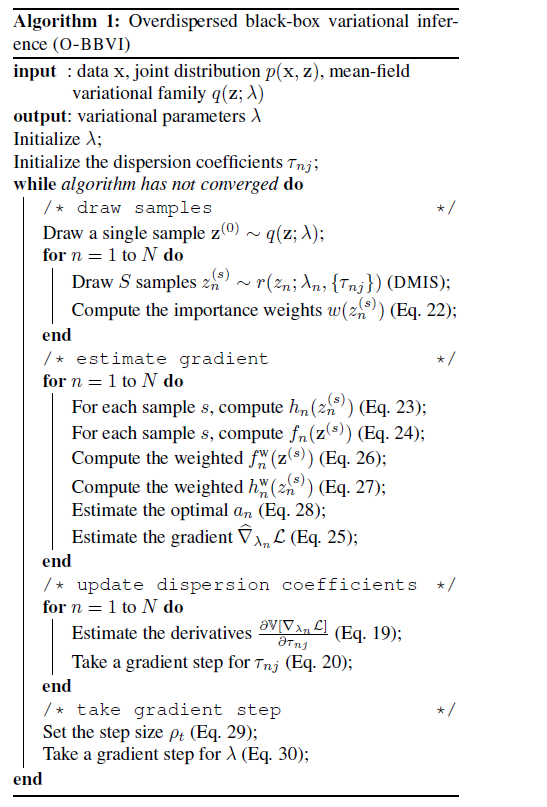Overdispersed Black-Box Variational Inference (2016)
Abstract
method to reduce the variance of MC estimator of the gradient in BBVI
- sample from the variational distn (X)
- use importance sampling
Proposed method : readily applied to any exponential family distn
Over-dispersed Importance sampling scheme provides lower variance than BBVI
1. Introduction
(1) Generative Probabilistic Modeling
- data generating process, through a joint distn of “observed data” & “latent variable”
- use an inference algorithm to calculate/approximate the posterior
(2) Variational inference
-
( traditional VI ) use coordinate-ascent to optimize its objective
( recent innovations ) use stochastic optimization
-
Must address the problem with MC estimates of gradient, which is HIGH VARIANCE
Several strategies to overcome this
- 1) Rao-Blackwellization
- 2) Reparameterization
- 3) Local expectations
In this paper, suggests O-BBVI (Overdispersed BBVI)
-
new method for reducing the variance of MC gradients
-
main idea = “use IMPORTANCE SAMPLING” to estimate the gradient
( in order to construct a good proposal distn that is matched to the problem )
Technical summary
-
probabilistic model : \(p(x,z)\)
-
VI : use parameterized distn of latent variables \(q(z ; \lambda)\)
build on BBVI
-
\(L(\lambda)\) : variational objective ( =negative KL-div + constant )
gradient of \(L(\lambda)\) : \(\nabla_{\lambda} \mathcal{L}=\mathbb{E}_{q(\mathbf{z} ; \lambda)}[f(\mathbf{z})]\)
where \(f(\mathbf{z})=\nabla_{\lambda} \log q(\mathbf{z} ; \lambda)(\log p(\mathbf{x}, \mathbf{z})-\log q(\mathbf{z} ; \lambda))\)
-
Approximate the gradient with importance sampling!
Introduce a proposal distn : \(r(\mathbf{z} ; \lambda, \tau)\)
-
depends on both (1) variational param & (2) additional param
-
result : \(\nabla_{\lambda} \mathcal{L}=\mathbb{E}_{r(\mathbf{z} ; \lambda, \tau)}\left[f(\mathbf{z}) \frac{q(\mathbf{z} ; \lambda)}{r(\mathbf{z} ; \lambda, \tau)}\right]\).
2. Black-Box Variational Inference (BBVI)
variational family \(q(z ; \lambda)\)
-
\(q(\mathbf{z} ; \lambda)=g(\mathbf{z}) \exp \left\{\lambda^{\top} t(\mathbf{z})-A(\lambda)\right\}\).
- \(g(\mathbf{z})\) : base measure
- \(\lambda\) : natural parameters
- \(t(\mathbf{z})\) : sufficient statistics
- \(A(\lambda)\) : log normalizer
-
goal : minimize \(D_{\mathrm{KL}}(q(\mathbf{z} ; \lambda) \mid p(\mathbf{z} \mid \mathbf{x}))\)
( = maximize ELBO, \(\mathcal{L}(\lambda)=\mathbb{E}_{q(\mathbf{z} ; \lambda)}[\log p(\mathbf{x}, \mathbf{z})-\log q(\mathbf{z} ; \lambda)]\) )
with tractable variational family & conditionally conjugate model \(\rightarrow\) closed form!
But, not in real world…
BBVI :
-
uses “MC estimates of gradient” & requires few model-specific calculations
-
relies on log-derivative trick ( = REINFORCE or score function )
-
score function :
\(\begin{array}{l} \nabla_{\lambda} q(\mathbf{z} ; \lambda)=q(\mathbf{z} ; \lambda) \nabla_{\lambda} \log q(\mathbf{z} ; \lambda) \\ \mathbb{E}_{q(\mathbf{z} ; \lambda)}\left[\nabla_{\lambda} \log q(\mathbf{z} ; \lambda)\right]=0 \end{array}\).
-
BUT, it may have HIGH VARIANCE
-
uses 2 strategies :
- 1) control variates
- 2) Rao-Blackwellization
(1) Control Variates
Properties
- (1) r.v included in estimator
- (2) same expectation + reducing variance
- (3) many possible choices
Weighted Score function
-
not model dependent :)
-
each component \(n\) of the gradient in \(\nabla_{\lambda} \mathcal{L}=\mathbb{E}_{q(\mathbf{z} ; \lambda)}[f(\mathbf{z})]\)
can be rewritten as…..
\(\mathbb{E}_{q(\mathbf{z} ; \lambda)}\left[f_{n}(\mathbf{z})-a_{n} h_{n}(\mathbf{z})\right]\).
-
result )
\(a_{n}=\frac{\operatorname{Cov}\left(f_{n}(\mathbf{z}), h_{n}(\mathbf{z})\right)}{\operatorname{Var}\left(h_{n}(\mathbf{z})\right)}\).
In BBVI, separate set of samples from \(q(\mathbf{z} ; \lambda)\) are used to estimate \(a_n\)
(2) Rao-Blackwellization
-
reduce variance of r.v, by “replacing it with its conditional expectation”
-
In BBVI, each component of the gradient is Rao-Blackwellized with respect to variables outside of the Markov blanket of the involved hidden variable
-
MFVI ) \(q(\mathbf{z} ; \lambda)=\prod_{n} q\left(z_{n} ; \lambda_{n}\right)\)
\(\begin{aligned} \nabla_{\lambda_{n}} \mathcal{L}=\mathbb{E}_{q\left(\mathbf{z}_{(n)} ; \lambda_{(n)}\right)}[& \nabla_{\lambda_{n}} \log q\left(z_{n} ; \lambda_{n}\right) \left.\times\left(\log p_{n}\left(\mathrm{x}, \mathbf{z}_{(n)}\right)-\log q\left(z_{n} ; \lambda_{n}\right)\right)\right] \end{aligned}\).
3. Overdispersed Black-Box Variational Inference (O-BBVI)
O-BBVI : method for further reducing the variance
main idea : use IMPORTANCE SAMPLING
( does not sample from variational distribution \(q(\mathbf{z} ; \lambda)\) )
Takes samples from a proposal distn, \(r(\mathbf{z} ; \lambda, \tau)\)
-
importance weights = \(w(\mathbf{z})=q(\mathbf{z} ; \lambda) / r(\mathbf{z} ; \lambda, \tau)\)
\(\rightarrow\) resulting estimator is unbiased
Optimal Proposal
one that minimizes the variance of the estimator is not variational distribution \(q(\mathbf{z} ; \lambda)\) !
Rather, it is….
\(r_{n}^{\star}(\mathbf{z}) \propto q(\mathbf{z} ; \lambda) \mid f_{n}(\mathbf{z}) \mid\).
- but not tractable
- thus, in O-BBVI, build an alternative proposal based on overdispersed exponential families
Overdispersed Proposal
motivation : optimal distn \(r_{n}^{\star}(\mathbf{z}) \propto q(\mathbf{z} ; \lambda) \mid f_{n}(\mathbf{z}) \mid\) assigns higher probability density to the tails of \(q(\mathbf{z} ; \lambda)\)
Thus, design a proposal distn \(r(\mathbf{z} ; \lambda, \tau)\), that assigns higher mass to the tail!
\[r(\mathbf{z} ; \lambda, \tau)=g(\mathbf{z}, \tau) \exp \left\{\frac{\lambda^{\top} t(\mathbf{z})-A(\lambda)}{\tau}\right\}\]- where \(\tau \geq 1\) is the dispersion coefficient of the overdispersed distn
Then, the estimator of the gradient is …
\(\widehat{\nabla}_{\lambda}^{\mathrm{O}-\mathrm{BB}} \mathcal{L}=\frac{1}{S} \sum_{s} f\left(\mathbf{z}^{(s)}\right) \frac{q\left(\mathbf{z}^{(s)} ; \lambda\right)}{r\left(\mathbf{z}^{(s)}\right)}, \quad \mathbf{z}^{(s)} \stackrel{\text { iid }}{\sim} r(\mathbf{z} ; \lambda, \tau)\).
Desired properties of \(r(\mathbf{z} ; \lambda, \tau)\)
- 1) easy to sample from
- 2) adaptive
- 3) higher mass to the tails of \(q(\mathbf{z} ; \lambda)\)
Dispersion coefficient \(\tau\) can be itself adaptive to better match the optimal proposal at each iteration of variational optimization procedure.
3-1. Variance Reduction
O-BBVI vs BBVI
(1) BBVI
- \(\widehat{\nabla}_{\lambda}^{\mathrm{BB}} \mathcal{L}=\frac{1}{S} \sum_{s} f\left(\mathbf{z}^{(s)}\right), \quad \mathbf{z}^{(s)} \stackrel{\mathrm{iid}}{\sim} q(\mathbf{z} ; \lambda)\).
- \(\mathbb{V}\left[\widehat{\nabla}_{\lambda}^{\mathrm{BB}} \mathcal{L}\right]=\frac{1}{S} \mathbb{E}_{q(\mathbf{z} ; \lambda)}\left[f^{2}(\mathbf{z})\right]-\frac{1}{S}\left(\nabla_{\lambda} \mathcal{L}\right)^{2}\).
(2) O-BBVI
\(\begin{aligned} \mathbb{V}\left[\widehat{\nabla}_{\lambda}^{\mathrm{O}-\mathrm{BB}} \mathcal{L}\right] &=\frac{1}{S} \mathbb{E}_{r(\mathbf{z} ; \lambda, \tau)}\left[f^{2}(\mathbf{z}) \frac{q^{2}(\mathbf{z} ; \lambda)}{r^{2}(\mathbf{z} ; \lambda, \tau)}\right]-\frac{1}{S}\left(\nabla_{\lambda} \mathcal{L}\right)^{2} \\ &=\frac{1}{S} \mathbb{E}_{q(\mathbf{z} ; \lambda)}\left[f^{2}(\mathbf{z}) \frac{q(\mathbf{z} ; \lambda)}{r(\mathbf{z} ; \lambda, \tau)}\right]-\frac{1}{S}\left(\nabla_{\lambda} \mathcal{L}\right)^{2} \end{aligned}\).

